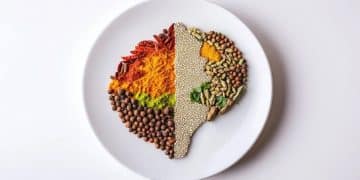Intermittent Fasting: Comprehensive Guide to Benefits and Risks

Intermittent fasting involves cycling between periods of eating and voluntary fasting, a dietary approach gaining significant attention for its potential health benefits, ranging from weight management to improved metabolic markers, but its efficacy and safety depend on individual health status and consistent practice.
In the evolving landscape of health and wellness, new dietary approaches frequently emerge, promising transformative results. Among these, intermittent fasting has distinguished itself, moving from a niche practice to a mainstream topic of discussion. This comprehensive guide aims to unpack whether this eating pattern is right for you, exploring its benefits, potential risks, and practical considerations.
Understanding Intermittent Fasting
Intermittent fasting (IF) is not a diet in the traditional sense, but rather an eating pattern that cycles between periods of eating and voluntary fasting. It doesn’t restrict specific foods but instead focuses on when you eat. This approach has roots in ancient traditions and has been practiced for centuries across various cultures for health, spiritual, or religious reasons. The modern interpretation of IF, however, is largely driven by its potential benefits for weight management and metabolic health.
The core principle behind IF involves extending the time your body spends in a fasted state. Typically, your body uses glucose from food for energy. After several hours without food, it depletes its glucose stores and begins burning fat for energy through a process called metabolic switching. This shift to fat burning is what many proponents believe offers several health advantages.
Common Intermittent Fasting Methods
There are several popular methods of intermittent fasting, each with its own schedule and approach. Understanding these variations is crucial for finding one that aligns with your lifestyle and health goals.
- 16/8 Method: This involves fasting for 16 hours each day and restricting your eating window to 8 hours. For example, you might eat between 12 PM and 8 PM, and fast for the remaining 16 hours. This is arguably the most popular and sustainable method for many.
- 5:2 Diet: With this method, you eat normally for five days a week and restrict your calorie intake to 500-600 calories on the other two non-consecutive days.
- Eat-Stop-Eat: This involves a full 24-hour fast once or twice a week. For instance, you might finish dinner on Monday and not eat again until dinner on Tuesday.
- Alternate-Day Fasting: This involves fasting every other day, either by not eating at all or by consuming a very small number of calories (e.g., 500 calories) on fasting days.
Each of these methods offers a different level of intensity and flexibility, making IF adaptable to various preferences. Regardless of the method, the key is consistency and ensuring adequate hydration and electrolyte intake during fasting periods. The effectiveness and safety of IF largely depend on how well it’s integrated into an individual’s overall lifestyle and dietary habits.
The Potential Benefits of Intermittent Fasting
Beyond weight loss, research suggests a range of potential health benefits associated with intermittent fasting. These benefits often stem from the metabolic changes that occur during the fasted state, impacting cellular processes and hormonal balance.
One of the most widely discussed benefits is its impact on weight management. By naturally reducing the eating window, many individuals find themselves consuming fewer calories overall. However, the benefits extend beyond simple caloric restriction. IF can help optimize hormone levels, particularly insulin, which plays a crucial role in fat storage. Lowered insulin levels facilitate the body’s ability to tap into stored fat for energy.
Metabolic Health and Disease Prevention
The metabolic effects of intermittent fasting are particularly intriguing. Studies have shown promising results in improving various markers associated with metabolic health.
- Insulin Sensitivity: IF can significantly improve insulin sensitivity, meaning your cells become more responsive to insulin. This is beneficial for preventing and managing type 2 diabetes.
- Blood Sugar Control: By influencing insulin and glucagon, IF helps stabilize blood sugar levels, reducing spikes and crashes.
- Cellular Repair (Autophagy): During fasting, the body initiates cellular repair processes, including autophagy, where cells remove old, damaged proteins and other cellular debris. This process is crucial for cellular health and longevity.
- Inflammation Reduction: Chronic inflammation is linked to numerous diseases. Some research indicates that IF can reduce markers of inflammation in the body.
Furthermore, early research suggests potential benefits for brain health, including increased production of brain-derived neurotrophic factor (BDNF), a protein that promotes the growth of new nerve cells and may protect against neurodegenerative diseases. While these findings are promising, it’s important to remember that much of this research is still in its early stages, often conducted on animals or with small human cohorts.
Potential Risks and Considerations
While intermittent fasting offers a compelling suite of potential benefits, it’s not a one-size-fits-all solution. There are significant risks and considerations that individuals should be aware of before adopting this eating pattern. Understanding these factors is crucial for making an informed decision about whether IF is appropriate for your specific health profile.
One of the primary concerns revolves around potential nutrient deficiencies. Restricting eating windows, especially for extended periods, can make it challenging to consume all necessary vitamins, minerals, and macronutrients. This is particularly true if the foods consumed during the eating window are not nutrient-dense. Over time, this could lead to deficiencies that impact overall health, energy levels, and even immune function.
Who Should Exercise Caution or Avoid IF?
Intermittent fasting, despite its popularity, is not suitable for everyone. Certain populations should exercise extreme caution or avoid IF altogether due to potential health risks:
- Pregnant or Breastfeeding Women: Nutritional needs are significantly higher during pregnancy and lactation. Fasting could compromise nutrient intake for both mother and child.
- Individuals with a History of Eating Disorders: IF can potentially trigger or exacerbate disordered eating patterns and an unhealthy relationship with food.
- People with Diabetes (especially Type 1) or on Blood Sugar-Lowering Medications: Fasting can lead to dangerously low blood sugar levels (hypoglycemia) in these individuals. Close medical supervision is essential if IF is considered.
- Children and Adolescents: Growing bodies and developing brains require consistent energy and nutrient intake.
- Individuals Underweight or with Chronic Medical Conditions: Fasting might exacerbate existing health issues or lead to further weight loss that is not desirable.

Beyond these specific groups, some common side effects can arise when starting IF, including headaches, fatigue, irritability, and difficulty concentrating. These often subside as the body adapts, but they indicate that careful monitoring is necessary. It’s imperative that anyone considering intermittent fasting, especially those with pre-existing health conditions, consults with a healthcare professional or a registered dietitian before making significant dietary changes. A personalized approach, guided by medical advice, can help mitigate risks and ensure IF is implemented safely and effectively.
How to Start Intermittent Fasting Safely
If you’re considering incorporating intermittent fasting into your lifestyle, a thoughtful and gradual approach is key to ensuring safety and sustainability. Rushing into extreme fasting protocols can lead to negative side effects and may not be beneficial in the long run. The goal is to allow your body time to adapt to new eating patterns.
Begin by choosing a method that feels manageable and least disruptive to your current routine. The 16/8 method, for instance, is often recommended for beginners due to its relative flexibility. You might start by gradually extending your overnight fast by an hour or two each day, rather than jumping straight into a full 16-hour fasting window. This allows your digestive system and metabolism to adjust without significant shock, minimizing initial discomforts like hunger pangs or headaches.
Essential Tips for a Successful Intermittent Fasting Journey
Once you’ve chosen a method, several practical steps can greatly improve your experience and success with intermittent fasting:
- Stay Hydrated: Drinking plenty of water, unsweetened tea, and black coffee during your fasting window is crucial. These beverages can also help curb hunger and maintain energy levels.
- Focus on Nutrient-Dense Foods: During your eating window, prioritize whole, unprocessed foods. Include plenty of lean proteins, healthy fats, complex carbohydrates, and a wide variety of fruits and vegetables. This ensures you’re getting all the necessary nutrients, preventing deficiencies.
- Listen to Your Body: Pay attention to hunger cues, energy levels, and overall well-being. If you feel unwell or experience persistent negative symptoms, reassess your fasting schedule or consult a healthcare professional.
- Plan Your Meals: Having a clear plan for your eating window helps ensure you’re consuming balanced meals and avoiding overeating or unhealthy choices.
- Electrolyte Balance: Especially during longer fasts, it’s important to monitor electrolyte intake. A pinch of sea salt in water can often help with electrolyte balance and prevent lightheadedness.
Remember that intermittent fasting is a tool, not a magic bullet. Its effectiveness is significantly enhanced when combined with a balanced diet, regular physical activity, and adequate sleep. Gradual implementation, coupled with careful monitoring of your body’s responses, will pave the way for a more successful and beneficial intermittent fasting experience.
Intermittent Fasting and Exercise
Integrating exercise with intermittent fasting is a common question and a topic of ongoing discussion. For many, the synergy between these two components can enhance overall health benefits, but understanding the nuances is crucial to optimize results and avoid potential pitfalls. The timing of workouts in relation to eating windows, as well as the intensity of exercise, can significantly impact performance, recovery, and the body’s adaptation to fasting.
Working out in a fasted state, particularly for moderate-intensity aerobic activities, may increase fat utilization for energy. This is because glycogen stores are lower, prompting the body to tap into fat reserves. However, for high-intensity or strength training, the benefits of working out in a fasted state are less clear and might even be detrimental to performance and muscle recovery. Glycogen is the primary fuel source for intense efforts, and its depletion can limit your ability to lift heavy or perform explosive movements effectively.
Optimizing Your Exercise Routine with IF
To safely and effectively combine intermittent fasting with your exercise regimen, consider these strategic approaches:
- Morning Fasted Workouts (Lower Intensity): If you prefer to train in the morning, opt for lower-intensity cardio or light strength training during your fasted state. Ensure you rehydrate and consume a nutrient-dense meal shortly after your eating window opens.
- Post-Workout Eating Window Alignment: For higher-intensity workouts or strength training, timing your session just before your eating window opens allows for immediate post-workout nutrition. This helps with muscle recovery and glycogen replenishment.
- Listen to Your Body’s Signals: Pay close attention to your energy levels. If you consistently feel fatigued, weak, or experience significant performance drops, your current IF schedule might not be compatible with your training intensity. Adjusting your eating window or the types of workouts might be necessary.
- Ensure Adequate Hydration and Electrolytes: This is especially vital during and after exercise, whether fasted or fed. Depleted electrolytes can lead to muscle cramps, fatigue, and headaches.

Ultimately, the optimal way to combine intermittent fasting and exercise is highly individual. Experiment with different timings and intensities, and observe how your body responds. Prioritizing consistent, effective workouts and balanced nutrition during your eating windows will remain paramount, regardless of your fasting schedule. Always consult with a fitness professional or healthcare provider if you have specific concerns or performance goals.
Common Misconceptions and Troubleshooting
Intermittent fasting, despite its rising popularity, is often surrounded by misconceptions and practical challenges. Addressing these can help individuals approach IF with realistic expectations and overcome potential obstacles. One common misconception is that IF is a license to eat anything you want during your eating window. This couldn’t be further from the truth. While IF focuses on timing, the quality of food consumed remains paramount for overall health and achieving desired outcomes like weight loss or improved metabolic markers. Fasting cannot compensate for a diet rich in processed foods, excessive sugars, or unhealthy fats.
Another prevalent myth is that skipping meals will inevitably slow down your metabolism. While prolonged, severe calorie restriction can indeed affect metabolism, the temporary and structured nature of intermittent fasting typically doesn’t lead to a metabolic slowdown. In fact, some studies suggest that IF may even help maintain resting metabolic rate due to its effects on hormone regulation and fat oxidation rather than muscle loss, provided adequate protein intake is maintained.
Addressing Challenges and Staying on Track
- Hunger Pangs: Initial hunger is common. Distract yourself with activities, drink plenty of water or unsweetened beverages. The body usually adapts within a few days or weeks.
- Fatigue and Irritability: These symptoms often arise from electrolyte imbalance or insufficient sleep. Ensure adequate hydration and sufficient rest. Consider adding a pinch of sea salt to water.
- Lack of Progress: If weight loss or other goals aren’t met, examine your eating window habits. Are you consuming too many calories or processed foods? Are you consistent with your fasting schedule?
- Social Challenges: Dining with friends or family can be tricky. Be upfront about your eating schedule, or choose methods that offer more flexibility, like the 5:2 diet, for social occasions.
- Female Hormonal Response: Some women may experience hormonal disruptions, irregular periods, or increased stress. If these occur, scale back the fasting intensity or duration, or consult a healthcare professional.
Troubleshooting with intermittent fasting often involves self-awareness and adjustment. What works for one person might not work for another, and flexibility is key. It’s important to approach IF as a lifestyle adjustment rather than a temporary fix, prioritizing overall well-being and health over strict adherence if adverse effects arise. Consulting a registered dietitian can provide personalized guidance, especially when encountering persistent difficulties.
Is Intermittent Fasting Right for You? Making an Informed Decision
Deciding if intermittent fasting is the right approach for you involves a careful evaluation of your health status, lifestyle, and individual goals. There’s no universal answer, as the effectiveness and safety of IF are highly individual. The journey begins with self-assessment and, ideally, a conversation with a healthcare professional. Consider your current health conditions, medication use, dietary habits, and your relationship with food. Are you looking for weight management, improved metabolic health, or simply a structured eating pattern? Your motivation and expectations are crucial in determining IF’s suitability.
Understanding the science behind IF, its potential benefits, and its risks, as discussed throughout this guide, empowers you to make an informed decision. For many, IF has been a transformative tool for health and wellness, offering a sustainable way to manage weight and improve metabolic markers. For others, it might not be the most appropriate or beneficial strategy, potentially leading to adverse effects or an unhealthy relationship with food.
Final Considerations and Professional Guidance
Before embarking on any intermittent fasting regimen, particularly if you have pre-existing health conditions, are on medication, or have a history of disordered eating, seeking advice from a medical professional or a registered dietitian is paramount. They can provide personalized guidance, assess potential risks, and help tailor a plan that aligns with your unique health needs and goals. This professional insight ensures that you adopt a safe and effective approach.
In conclusion, intermittent fasting is a powerful tool when applied thoughtfully and responsibly. It’s not just about when you eat, but also about what and how much you eat during your eating periods. Combine IF with a nutrient-dense diet, regular physical activity, adequate sleep, and mindful eating practices. By doing so, you can harness its potential benefits while minimizing associated risks. Your health journey is personal, and choosing the right path requires careful consideration and a commitment to listening to your body.
| Key Point | Brief Description |
|---|---|
| ⏰ Key Methods | Explores 16/8, 5:2, Eat-Stop-Eat, and Alternate-Day Fasting. |
| 💪 Potential Benefits | Discusses weight loss, improved insulin sensitivity, autophagy, and reduced inflammation. |
| ⚠️ Risks & Caution | Highlights risks for pregnant women, diabetics, and those with eating disorders. |
| 💡 Starting Safely | Emphasizes gradual adaptation, hydration, nutrient-dense foods, and listening to your body. |
Frequently Asked Questions About Intermittent Fasting
▼
The 16/8 method is often cited as one of the most effective and sustainable for weight loss due to its relative simplicity. It involves fasting for 16 hours and having an 8-hour eating window. Its effectiveness stems from reducing overall calorie intake naturally and promoting metabolic switching, where the body starts burning fat for energy. Consistency and healthy food choices during the eating window are crucial for success.
▼
Contrary to common belief, correctly implemented intermittent fasting is not typically associated with a metabolic slowdown. Short-term fasting might even temporarily boost metabolism through increases in norepinephrine. However, prolonged periods of severe calorie restriction (beyond standard IF protocols) might eventually lower metabolic rate. The key is to ensure adequate nutrient and calorie intake during your eating windows to support metabolic health.
▼
Yes, it can be safe to exercise while intermittent fasting, but timing and intensity matter. Low-to-moderate intensity workouts in a fasted state may promote fat burning. For high-intensity or strength training, it’s often better to time your workout closer to your eating window to ensure adequate energy and aid muscle recovery. Always listen to your body and prioritize hydration and electrolyte balance.
▼
When starting intermittent fasting, common side effects include headaches, fatigue, irritability, difficulty concentrating, and hunger pangs. These symptoms usually subside within a few days or weeks as your body adapts to the new eating pattern. Staying well-hydrated, ensuring adequate sleep, and gradually increasing your fasting periods can help minimize these initial discomforts.
▼
Intermittent fasting is not suitable for everyone. Pregnant or breastfeeding women, individuals with a history of eating disorders, people with type 1 diabetes or those on blood sugar-lowering medications, and children/adolescents should generally avoid IF. Anyone with chronic medical conditions should consult a healthcare professional before considering this eating pattern to ensure it’s safe and appropriate for their specific health needs.
Conclusion
The decision to adopt intermittent fasting is a deeply personal one, requiring careful consideration of its potential benefits, inherent risks, and individual suitability. As this comprehensive guide has explored, IF offers various methods, each with the potential to improve metabolic health, support weight management, and foster cellular repair. However, it is not a panacea and carries specific considerations for certain populations. A holistic approach that integrates a nutrient-dense diet, regular physical activity, and ample rest remains foundational to any truly effective health strategy. Ultimately, IF serves as a powerful tool in the wellness arsenal when implemented mindfully, adapted to personal needs, and ideally, guided by professional medical advice. Listening to your body and prioritizing long-term well-being above all else will be your most reliable compass in navigating this dietary approach.





